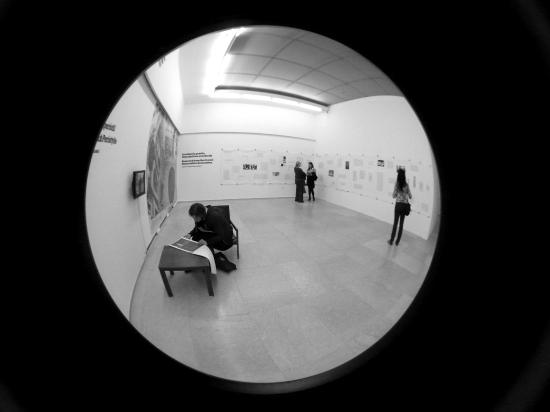Dissociative Association
Association outside the programmatic collectivities of the 1960s and 1970s in Socialist Croatia.
Concept: Ivana Bago and Antonia Majaca
With an intervention by BADco.
Research associate: Ana Kovacic
Dissociative Association developes as a part of the exhibition Political Practices of (post) Yugoslav Art (2009) and focuses on the forms of self-organisation in the Yugoslav art of the 1960's and 1970s.� It focues on the practices that emerged qua open experiment and whose formats, objectives and duration were as uncertain as any joint programme and objectives that were supposed to unite and define them.
The exhibition stems from a consideration of the three-year activity of the Podroom Working Community of Artists - a working and exhibition venue that between 1978 and 1981 brought together the key figures of the New Artistic Practice in Zagreb.
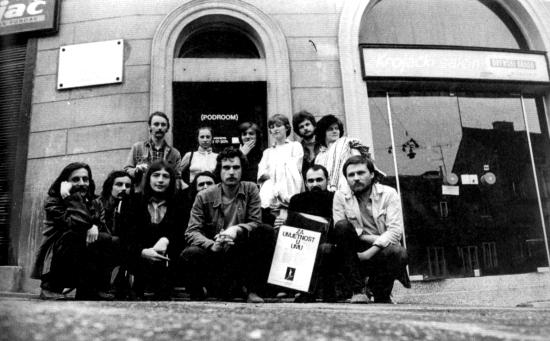
A transcript of a conversation (a working meeting) held in Podroom and published in the “catalogue-journal” First Issue (1980), which is a summary of the work to date as well as an attempt to sketch out a continuation of the activities of this “community”, serves as a point of departure for the rendering of narrative about self-organised artistic initiatives and the history of associations from Gorgona at the beginning of the 1960s to the establishment of the PM Gallery in 1981.
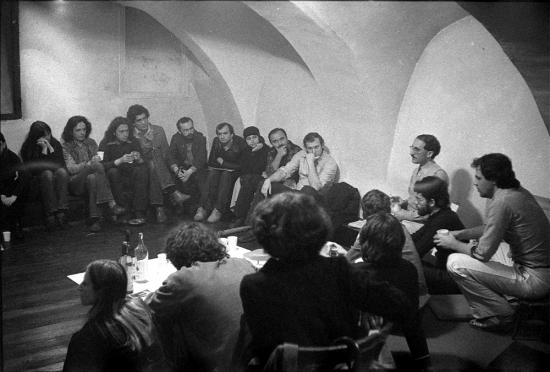
The sites of the actions of these initiatives – streets, nature, bathing places, university buildings, house entrances, balconies, cellars and windows – not only extra-institutional locations but “places of temporariness” as well, are on this occasion also considered as places of indefiniteness and ultimately as places with no programme. Research thus becomes a “search for the history of searching” – an interstitial space, a manner of working (“a form of action”) outside, bypassing, in the midst of and despite existing artistic institutions and conventions, as well as a manner of working that steps outside the framework of contemporary art and intervenes in settled cultural policies, and hence into the political and economic configurations of power. What is common to all the initiatives of the association of artists that are in focus here, irrespective of their duration, is the specific, non-programmatic and organic manner in which they group together around an only just adumbrated common goal. The artistic initiatives are looked at as a need for activity through association and getting together (as being-with) in the case of artists who do not necessarily wish to be bound to each other, rather to find some common approaches, for the purpose of remaining independent.
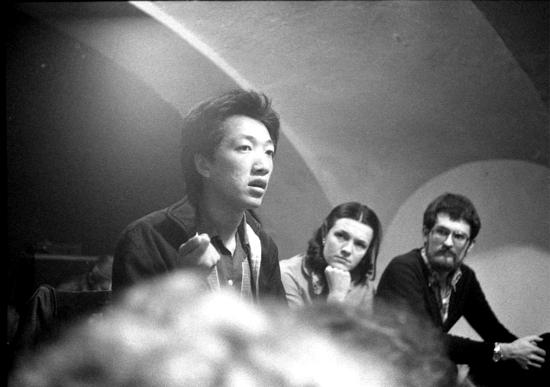
The Belgrade fragment of the project is focused on precisely such temporary manifestations of collectiveness, on models of “being singular plural” or more exactly, on being-with as a search for a different understanding of the relation between individual and collective, and then for the point of a collective itself, the possibility of a joint programme. It is precisely in this kind of observation that the transgressivity of working according to the given case is brought out, of working as “negative action” as well, ultimately, the subversion of the manner in which the dominant ideology defines the concept of action, collectivity and programme.

The transcript of the working meeting of Podroom referred to is a kind of scenario that defines the very presentation of the material, the contents of which are original written and visual documents, as well as a collection of more or less arbitrarily connected and disconnected associations, quotes and fragmentary narratives. The title Removed from the Crowd (taken from the title of a piece by Mladen Stilinović) thus becomes a signifier not only of the differentiation of the “associated individuals” as against the ideologically propagated collectivity, but also a signifier of the actual methodology of work on the project. Accordingly, the intention of the project is not the creation of a “convincing” and scientifically well-grounded historical or art-historical narrative, rather the indication of an associative cartography from the facts that we consider to be relevant to us today as well as from a series of speculations derived from the enlargement of details, deliberate omissions, arbitrary connections, all in the aid of articulating a different viewpoint, a temporary and unstable truth through a different “performance” of the writing of the history of contemporary art.
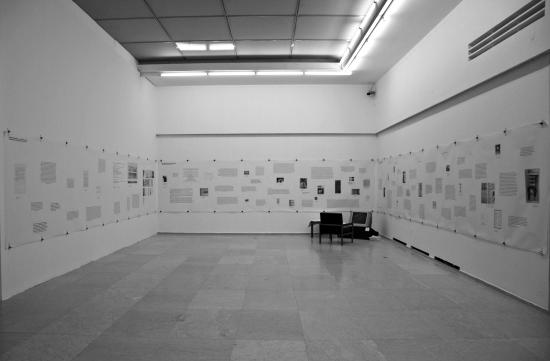
The history of art as a performative is then literally carried out by collaboration with the Zagreb based collaborative performance collective BADco. BADco. proposes - based on questions around artist's work beyond the production of artwork, self-organized activities outside institutional framings, issues of collective action, reassessment of own past work and other questions raised by the discussion of Artistic Labor Association Podroom - to create a matrix for a kind of self-interview within the BADco. collective itself. The contextual displacement of questions into a different era and a different collective is going to generate a new set of conteporary methodological questions that will serve as a script for a discussion with curators and arists within the PPYUART exhibition: questions in response to questions: questions from 1980 seeking answers in 2009, and questions from 2009 seeking answers in 1980.
Thirty years ago an exhibition of twenty artists was displayed in a cellar at Mesnička Street 12 in Zagreb, thus marking the formal opening of the gallery called the ‘Podroom’ (The Cellar). The date was May 24, 1978. The exhibition gathered an informal group of artists who would soon, in view of their future joint public appearances, use the name Radna Zajednica Umjetnika (RZU—“Working Community of Artists”). Before closing the gallery, RZU Podroom organized a talk—a self-interview—which was published in their first and only issue of the magazine entitled Prvi broj (The First Issue).
As a format of self-interviewing, BADco. decided to produce new questions on the basis of RZU Podroom’s discussion and inscribe it into the original text, adding also the stage-directions which suggest formats of an open-discussion in BADco.’s performances.

The text “Spit in the eye of truth (then quickly shut your eyes to it)” published in the exhibition catalogue is a long-lasting experiment in “performative writing” related to the Removed from the Crowd project, which does not close with a one-off publication of a text; rather the text is considered as an open form that is incessantly built on and transformed through each new performance. Its non-linear structure stems from the lasting process of reading, looking, listening and thinking with and about the phenomena and actors of the conceptual artistic practices of the 1960s and 1970s in Yugoslavia. The text, a collaborative experiment in writing, started in September 2008, lasted for several months and had its first “performance” in the collection of texts that we edited called Issuing the Revolution in the shape of the 83rd issue of the journal Život umjetnosti [Life of Art] of the Institute for Art History in Zagreb. The text, and the project as a whole, represents a search for the ways in which the artists and groups of artists in the 1960s and 1970s defined themselves and identified their own tactics, the models of differentiation from the institutional structures and ultimately the forms of activity and shapes of action that we read as political practices within a specific cultural, social and political constellation.
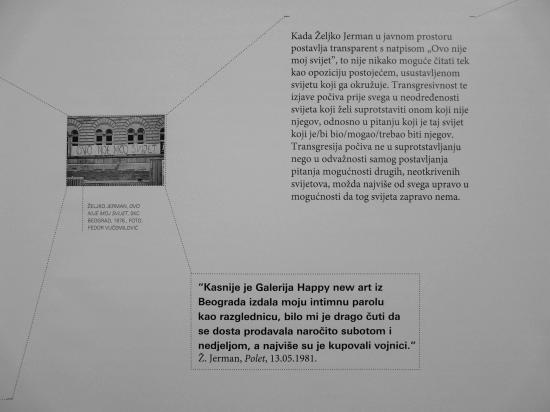
Instead of offering an analysis of individual art groups, the text deals with the background, the motivation and the (non)programmed nature of the work of the individual artists, the art groups and initiatives, focusing on two uniting elements: the search for a space between the individual and the collective approach to activity on the one hand and the avoidance or even the rejection of any defined programme of activity that might possibly become a key for a monosemic reading. The basic narrative of the text is opened up with a number of secondary associations, textual fragments that sometimes figure as found footage, as evidence, and sometimes only as interim but potentially rewarding and revealing bypaths by which the place of fortuity, unpredictability and in consequence of the non-programmatic itself is emancipated.
The project Political Practices of (post) Yugoslav Art (PPYUART) was initiated by the four organizations in 2006: Prelom kolektiv (Belgrade), WHW kolektiv (Zagreb), kuda.org (Novi Sad) i CCA/pro.ba (Sarajevo) as the long term multidisciplinary research, which traces, articulates and debates about the intrerrelationships of visual arts, intellectual production and socio-political practices in the given social conjuncture. It tries to give back the political voice to the art which has been taken from it, both actively (through the domination of “cultural industries” approach) and retroactively (through the way it is historicized).
* * *
Exhibition Political Practices of (post) Yugoslav Art: RETROSPECTIVE 01, Museum 25th of May, November 29th– December 31st 2009
Exhibition participants:
Curators-researchers: DeLVe (Ivana Bago and Antonia Majača) / kuda.org (Zoran Pantelić, Branka Ćurčić, Borka Stojić) / Kunsthistorisches Mausoleum / Prelom Kolektiv (Radmila Joksimović, Zorana Dojić, Dušan Grlja, Jelena Vesić) / SCCA/pro.ba (Dunja Blažević, Asja Hafner) / WHW (Ivet Ćurlin, Ana Dević, Nataša Ilić, Sabina Sabolović, Dejan Kršić) / Ana Janevski / Miklavž Komelj, Lidija Radojević, Tanja Velagić, Jože Barši.
Artists: Chto Delat (u saradnji sa/in collaboration with Vladan Jeremić i/and Rena Raedle) / Igor Grubić / Dejan Habicht i/and Tanja Lažetić / David Maljković / Darinka Pop-Mitić / Hito Steyerl.
Working group of the exhibition PPPYUart:RETROSPECTIVE 01
Jelena Vesić (curator), Radmila Joksimović (coordinator), Zoran Pantelić (exhibition design), Vladimir Jerić (technical consultant)


